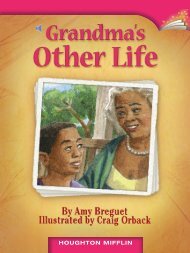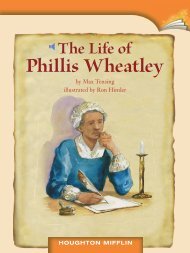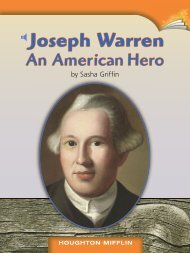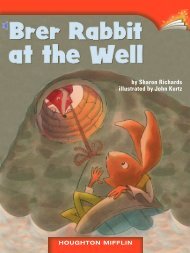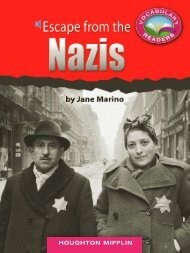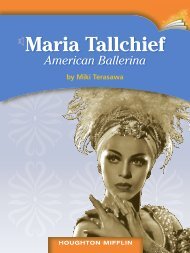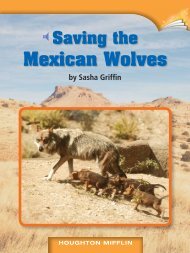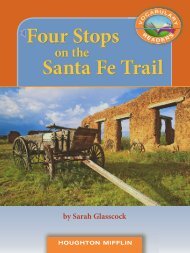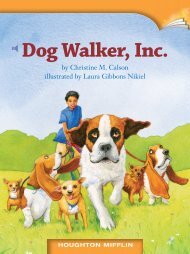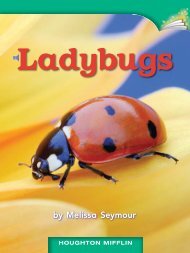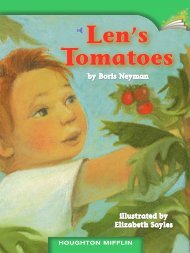Lesson 14:Thomas Peters A Remarkable Man
Lesson 14:Thomas Peters A Remarkable Man
Lesson 14:Thomas Peters A Remarkable Man
You also want an ePaper? Increase the reach of your titles
YUMPU automatically turns print PDFs into web optimized ePapers that Google loves.
<strong>Thomas</strong> <strong>Peters</strong><br />
A <strong>Remarkable</strong> <strong>Man</strong><br />
by Susannah Flaherty<br />
HOUGHTON MIFFLIN
<strong>Thomas</strong> <strong>Peters</strong><br />
A <strong>Remarkable</strong> <strong>Man</strong><br />
by Susannah Flaherty<br />
ILLUSTRATION CREDIT: Title Page Bandelin-Dacey Studios.<br />
PHOTOGRAPHY CREDITS: Cover © Peter Harholdt/SuperStock. 2 The Granger Collection, New York. 7 Private Collection,<br />
Peter Newark American Pictures/The Bridgeman Art Library. 9 American Museum, Bath, Avon, UK, Courtesy of the Director,<br />
National Army Museum, London, UK / The Bridgeman Art Library. 10 The Granger Collection, New York. 11 The Art Archive.<br />
13 © Peter Harholdt/SuperStock, Inc. 15 The Granger Collection, New York. 17 The Granger Collection, New York.<br />
Copyright © by Houghton Mifflin Company. All rights reserved.<br />
No part of this work may be reproduced or transmitted in any form or by any means, electronic or mechanical, including<br />
photocopying or recording, or by any information storage or retrieval system without the prior written permission of the<br />
copyright owner unless such copying is expressly permitted by federal copyright law. With the exception of nonprofit<br />
transcription into Braille, Houghton Mifflin is not authorized to grant permission for further uses of this work. Permission<br />
must be obtained from the individual copyright owner as identified herein. Address requests for permission to make copies<br />
of Houghton Mifflin material to School Permissions, Houghton Mifflin Company, 222 Berkeley Street, Boston, MA 02116.<br />
Printed in China<br />
ISBN-13: 978-0-547-02285-7<br />
ISBN-10: 0-547-02285-9<br />
1 2 3 4 5 6 7 8 9 RRD 15 <strong>14</strong> 13 12 11 10 09 08
Table of Contents<br />
Introduction 3<br />
<strong>Thomas</strong> <strong>Peters</strong>’s Early Life 4<br />
Promises of Freedom 6<br />
A Free <strong>Man</strong> 8<br />
The British Are Defeated 10<br />
Escape from Slavery 11<br />
Passage to Nova Scotia 12<br />
The Sierra Leone Company <strong>14</strong><br />
Passage to Africa—and Freedom 16<br />
Conclusion 17
Introduction<br />
During the American Revolution, colonial<br />
Patriots fought for “life, liberty, and the pursuit of<br />
happiness.” Their struggle for freedom from Britain<br />
is well known.<br />
But other people also wanted liberty. One group<br />
is largely unknown, even today. Who were those<br />
people They were black Africans and their descendants.<br />
These people were enslaved in the American<br />
colonies.<br />
Around 1750, there were about 300,000 enslaved<br />
people in the colonies. Most were African. They were<br />
about 20 percent of the total colonial population.<br />
The Slave Trade<br />
European slave-trading companies made thousands of trips to<br />
West Africa. Historians think that these companies brought 10<br />
to 12 million Africans into slavery in the Americas.<br />
3
During the Revolutionary War, some enslaved black<br />
people fought with the Patriots. However, historians<br />
believe that many more ran away from their masters.<br />
They risked their lives to join the British, or Loyalists.<br />
Why did so many enslaved people support the British<br />
What became of these people after the war This book<br />
answers these questions. It tells the true story of one<br />
man—<strong>Thomas</strong> <strong>Peters</strong>. He worked hard to gain life, liberty,<br />
and the pursuit of happiness for himself and others.<br />
<strong>Thomas</strong> <strong>Peters</strong>’s Early Life<br />
<strong>Thomas</strong> <strong>Peters</strong> was born<br />
in an area in West Africa.<br />
That area is now part of<br />
Nigeria. As a young man,<br />
<strong>Thomas</strong> was kidnapped. He<br />
was taken to North America.<br />
He was sold into slavery<br />
around 1760.<br />
NORTH<br />
AMERICA<br />
<strong>Thomas</strong> <strong>Peters</strong>’s journey<br />
into slavery, around 1760<br />
4
In the early 1770s, <strong>Peters</strong> was sold again. This<br />
time he was sold to a colonist named William<br />
Campbell. Campbell lived on the Cape Fear River in<br />
North Carolina. The local industry was logging trees<br />
and milling them into lumber. <strong>Peters</strong> was made an<br />
apprentice to a millwright.<br />
There were many conflicts between the colonists<br />
and the British government. These conflicts became<br />
very bad in 1774. In the spring of 1775, battles were<br />
fought in Lexington and Concord. The battles marked<br />
the beginning of the Revolutionary War.<br />
Rumors spread<br />
among the colonists in<br />
North Carolina. <strong>Man</strong>y<br />
colonists were afraid<br />
ATLANTIC<br />
that the British would<br />
OCEAN<br />
encourage enslaved<br />
blacks to fight against<br />
AFRICA the colonists. This would<br />
make the colonists’ fight<br />
Nigeria against the British more<br />
difficult.<br />
5
Promises of Freedom<br />
The colonists’ fears came true in November 1775. Lord<br />
Dunmore was the British governor of Virginia. He was a<br />
powerful Loyalist. Lord Dunmore made a remarkable offer.<br />
He promised freedom to any black person enslaved by a<br />
Patriot. The person had to agree to fight for the British. (This<br />
offer was not made to black people enslaved by Loyalists.)<br />
News of Lord Dunmore’s offer spread quickly. <strong>Man</strong>y<br />
colonists were angry. They thought enslaved blacks were<br />
their “property.” So the colonists felt that Lord Dunmore<br />
was stealing their property. The colonists also felt that Lord<br />
Dunmore wanted to cause unrest.<br />
Even so, Lord Dunmore’s offer had the effect he<br />
wanted. It inspired many blacks—including <strong>Thomas</strong><br />
<strong>Peters</strong>—to escape. These people then joined the British<br />
troops and claimed their liberty.<br />
“And I hereby further declare all indentured<br />
Servants, Negroes, or others, (appertaining to Rebels,)<br />
free that are able and willing to bear Arms, they joining<br />
His MAJESTY’S Troops as soon as may be.”<br />
This quote is from Lord Dunmore’s offer. He said that an enslaved<br />
person could become free by joining the British troops. The same<br />
was true for an indentured servant.<br />
6
Black Patriots in the Revolution<br />
Why didn’t the Patriots let enslaved blacks fight on their side,<br />
too At the start of the Revolutionary War, the Patriots did do<br />
this. Black Patriots, both free and enslaved, fought beside<br />
colonists. They fought at the battles of Lexington, Concord,<br />
and Bunker Hill.<br />
However, later in 1775,<br />
General George Washington<br />
stopped blacks from serving<br />
in the Continental Army.<br />
There were many reasons for<br />
his decision. Most Patriots<br />
did not want to give<br />
weapons to people they had<br />
enslaved. The Patriots feared<br />
that the enslaved people<br />
might fight against them.<br />
As the war went on, the<br />
Continental Army needed<br />
more soldiers. Then<br />
Washington changed his<br />
mind. The colonists were<br />
tentative, or unsure, about<br />
having enslaved black<br />
people fight. But<br />
Washington let these<br />
people join the army.<br />
General George Washington led<br />
the Continental Army.<br />
7
A Free <strong>Man</strong><br />
When <strong>Thomas</strong> <strong>Peters</strong> had a chance to be free, he took<br />
it. In early 1776, British ships sailed up the Cape Fear River.<br />
<strong>Peters</strong> learned that the British were nearby. He fled from<br />
bondage to join them. Because of Lord Dunmore’s offer,<br />
<strong>Peters</strong> was now a free man.<br />
<strong>Peters</strong> joined the Black Pioneers. This was a British<br />
army unit made up of black men. The Pioneers did not<br />
fight. But they still made major contributions to the<br />
Loyalist cause. Some worked as army scouts and raiders.<br />
Others were military engineers. They built housing and<br />
forts for soldiers. Sometimes they built defenses during<br />
battles. These were very dangerous conditions for work.<br />
The Black Brigade<br />
During the Revolutionary War, British army authorities<br />
organized other groups of freed blacks. One of the most<br />
famous was the Black Brigade. The Brigade made surprise<br />
attacks on Patriot forces. The Brigade fought with great<br />
dexterity. They captured prisoners and seized supplies. Their<br />
leader was a black Loyalist known as Colonel Tye.<br />
8
<strong>Peters</strong> stayed with the<br />
Black Pioneers until the war<br />
ended. He was promoted to<br />
sergeant.<br />
In 1779, the British<br />
made an influential statement.<br />
It was known as the<br />
Philipsburg Proclamation.<br />
Before, the British had only<br />
granted freedom to<br />
enslaved men. But the<br />
British General Henry Clinton<br />
Philipsburg Proclamation made the Philipsburg<br />
Proclamation in 1779.<br />
expanded the British offer.<br />
Now enslaved women and children could also be freed.<br />
They, too, had to run away from their colonial masters and<br />
join the British forces. Then they would be free.<br />
Historians believe that sometime after the Philipsburg<br />
Proclamation, an enslaved black woman named Sally<br />
escaped from her Patriot master. She reached a British<br />
army camp. At some point, she met <strong>Thomas</strong> <strong>Peters</strong>. Later,<br />
they married and had children.<br />
9
The British Are Defeated<br />
In October 1781, George Washington’s army defeated<br />
the British troops led by British general Lord Cornwallis.<br />
The battle took place at Yorktown, Virginia. This was an<br />
important victory for the Americans. It marked the real<br />
end of the Revolutionary War.<br />
At Yorktown, black Loyalist soldiers were among<br />
Cornwallis’s British troops. After the British surrendered,<br />
the black Loyalist soldiers were rounded up and returned<br />
to slavery. Unfortunately, this happened to many black<br />
Loyalists after the war.<br />
Late in 1782, the British agreed to recognize the former<br />
American colonies as an independent nation. Then the<br />
Americans made a demand. They said that the British must<br />
return all American property. Among the “property” were<br />
thousands of formerly<br />
enslaved people who<br />
had joined the British<br />
during the war.<br />
The British<br />
surrendered at<br />
Yorktown.<br />
10
Escape from Slavery<br />
Black Loyalists were afraid of being forced back into<br />
slavery. A man named Boston King later wrote about his<br />
feelings. He felt “inexpressible anguish and terror… <strong>Man</strong>y<br />
slaves had very cruel masters.” The thought of returning to<br />
slavery “embittered life to us.”<br />
The British commander, Sir<br />
Guy Carleton, did not agree to the<br />
American demand. He would not<br />
turn in the black Loyalists. Instead,<br />
he arranged for many of them to<br />
leave the colonies. Carleton got ships<br />
to take black Loyalists to places<br />
A medal marking the<br />
controlled by the British. Some<br />
end of slavery in the<br />
black Loyalists were taken to Nova British Empire<br />
Scotia in Canada. Others went to<br />
Jamaica in the Caribbean. Others went to Great Britain.<br />
Not all black Loyalists were able to escape from<br />
America. <strong>Man</strong>y were captured by American soldiers and<br />
returned to slavery. But 3,000 to 4,000 black Loyalists did<br />
escape. <strong>Thomas</strong> <strong>Peters</strong> and his family were among them.<br />
They got on a British ship. The ship took them from New<br />
York to Nova Scotia around the beginning of 1783.<br />
11
Passage to Nova Scotia<br />
CANADA<br />
New<br />
Brunswick<br />
Halifax<br />
Brindley Town<br />
Nova<br />
Scotia<br />
New York<br />
ATLANTIC<br />
OCEAN<br />
New York City<br />
The <strong>Peters</strong> family went by ship from New York to Nova Scotia.<br />
The ship carrying the <strong>Peters</strong> family was blown off<br />
course. The people from the ship had to spend the winter in<br />
the Caribbean. They finally arrived in Nova Scotia, Canada,<br />
in 1784. After they arrived, the <strong>Peters</strong> family and other black<br />
Loyalists settled in Brindley Town.<br />
All Loyalists—including formerly enslaved Africans—<br />
were promised a hundred acres of farmland. They were also<br />
promised tools and provisions to last them three years. But<br />
<strong>Peters</strong>’s group received provisions to last them only a few<br />
months. And they did not get the land.<br />
12
<strong>Peters</strong> and his community waited for their land. They<br />
worked building roads to earn their provisions. They were<br />
kept apart from white Loyalist settlers. They had to live in<br />
very poor settlements.<br />
<strong>Thomas</strong> <strong>Peters</strong> wrote to the governor of Nova Scotia.<br />
He asked the governor for the land. The governor finally<br />
gave some black Loyalist families one-acre “town plots.”<br />
But the black Loyalists never received their large farming<br />
plots. The families barely survived.<br />
<strong>Peters</strong> kept trying to persuade the governor to give the<br />
promised farmlands. But all his efforts were unsuccessful.<br />
The black families did not receive the land.<br />
In 1790, <strong>Peters</strong> traveled to Great<br />
Britain. He decided to ask the British<br />
government in person. He would<br />
speak for hundreds of black<br />
Loyalists. The long trip to London,<br />
England, was risky. The ship had to<br />
cross the Atlantic Ocean. Pirates<br />
could have captured <strong>Peters</strong>. They<br />
might have enslaved him again.<br />
<strong>Peters</strong> sailed to England in 1790,<br />
possibly on a ship like this one.<br />
13
The Sierra Leone Company<br />
Finally, <strong>Thomas</strong> <strong>Peters</strong> arrived safely in England.<br />
There he met a man named Granville Sharp. Sharp was<br />
famous for working against slavery. Sharp helped <strong>Peters</strong><br />
deliver a petition, or written request, to the British<br />
government.<br />
The petition listed every aspect of the black Loyalists’<br />
problems. They had not received the promised farmlands.<br />
They had not received tools or provisions. But that was not<br />
all. The British denied the black Loyalists many rights.<br />
A black Loyalist could not have a trial by jury. A black<br />
Loyalist could not bring problems to courts of law. A black<br />
Loyalist could not vote.<br />
Granville Sharp offered more help to <strong>Peters</strong>. Sharp told<br />
<strong>Peters</strong> about the Sierra Leone Company. This company was<br />
created by Sharp and other British abolitionists, or people<br />
who wanted to end slavery. The abolitionists wanted to<br />
create a colony in Sierra Leone, Africa. This colony would be<br />
a place for freed Africans. The first attempt to establish the<br />
colony failed. Now the abolitionists were looking for a new<br />
group to settle in Sierra Leone.<br />
<strong>14</strong>
<strong>Peters</strong> thought that the<br />
Sierra Leone colony was a good<br />
idea. The colony might solve the<br />
black Loyalists’ problems.<br />
<strong>Peters</strong> agreed to Sharp’s idea.<br />
Then the Sierra Leone<br />
Company presented a new<br />
plan to the British government. <strong>Man</strong>y people in England<br />
In the plan, <strong>Peters</strong> and other wanted to end slavery. This<br />
painting shows a meeting<br />
black Loyalists would settle in of abolitionists in London<br />
Sierra Leone.<br />
in 1840.<br />
The British government<br />
agreed to move the Loyalists from Nova Scotia to Sierra<br />
Leone. The British promised free passage and 20 acres of<br />
land to each black Loyalist. More acres were added for<br />
family members. The plan was approved. <strong>Peters</strong> left<br />
England and returned to Nova Scotia.<br />
<strong>Peters</strong> informed others about the Sierra Leone colony.<br />
One flyer said, “Free Settlement on the Coast of Africa.”<br />
<strong>Man</strong>y black Loyalists agreed to the plan. Moving to Sierra<br />
Leone seemed like a good idea. The black Loyalists were<br />
tired of struggling in Nova Scotia.<br />
15
Passage to Africa—and Freedom<br />
The Sierra Leone Company did not expect many new<br />
settlers. The company thought only a few hundred black<br />
Loyalists would want to move. They were wrong. Nearly<br />
1,200 people were interested! <strong>Thomas</strong> <strong>Peters</strong> helped organize<br />
the settler families. In 1791, a group of ships sat in Halifax<br />
harbor. The ships were ready for the trip to West Africa.<br />
The black Loyalists set sail for Africa on January 15, 1792.<br />
<strong>Peters</strong> and his family were among the new settlers. There<br />
were weeks of raging storms at sea. Finally, in early March,<br />
the entire fleet arrived safely. The settlers were free. They<br />
could begin new lives!<br />
<strong>Peters</strong> and the other Loyalists cleared land for a new<br />
settlement. They were hopeful about their new lives. They<br />
named the settlement Freetown.<br />
The Death of <strong>Thomas</strong> <strong>Peters</strong><br />
<strong>Thomas</strong> <strong>Peters</strong> did not live long after arriving in Sierra Leone.<br />
He died of malaria on June 25, 1792. But his legacy remains.<br />
The founding of Freetown was an important moment in<br />
black history. The settlement would provide freedom, equal<br />
rights, and land to formerly enslaved people. This was an<br />
important step toward ending slavery.<br />
16
The settlers faced many challenges in Sierra Leone.<br />
However, their situation got better. Great Britain outlawed<br />
the slave trade in 1807. Freetown became a center for the<br />
fight against the slave trade. <strong>Man</strong>y formerly enslaved<br />
people came to live there. Freetown became the capital of<br />
Sierra Leone. Descendants of the original settlers still live<br />
there today.<br />
Conclusion<br />
The story of <strong>Thomas</strong><br />
<strong>Peters</strong> and the black<br />
Loyalists is remarkable.<br />
The story starts with<br />
slavery in America and<br />
ends with freedom in<br />
Africa. The lives of these<br />
The British attacked a<br />
settlers are not well known. Spanish slave-trading<br />
But they are an important center in Sierra Leone.<br />
part of American history.<br />
<strong>Thomas</strong> <strong>Peters</strong> was caught in the fight between the<br />
British and the colonial Patriots. He and other enslaved<br />
blacks got the chance to gain their own freedom. They<br />
created one of the largest rebellions of enslaved people in<br />
American history.<br />
17
The Life of <strong>Thomas</strong> <strong>Peters</strong><br />
Pre-1760<br />
About 1760<br />
Fall 1775<br />
Early 1776<br />
June 1779<br />
Fall 1781<br />
<strong>Thomas</strong> <strong>Peters</strong> is born in West Africa.<br />
He is sold into slavery in the American<br />
colonies.<br />
Lord Dunmore’s Proclamation is made.<br />
<strong>Peters</strong> escapes from slavery and joins the<br />
Black Pioneers.<br />
The Philipsburg Proclamation is made.<br />
The British surrender at Yorktown.<br />
1782-1783 The British arrange for many black<br />
Loyalists to leave the U.S. and travel to<br />
Nova Scotia, Jamaica, or Great Britain.<br />
1784 The <strong>Peters</strong> family arrives in Nova Scotia<br />
but lives under poor conditions.<br />
1790 <strong>Peters</strong> travels to England and meets<br />
Granville Sharp of the Sierra Leone<br />
Company.<br />
January 1792 <strong>Peters</strong> sails to Sierra Leone, Africa.<br />
He helps start Freetown with other black<br />
Loyalists.<br />
June 1792<br />
<strong>Peters</strong> dies of malaria in Freetown.<br />
18
Responding<br />
TARGET SKILL Sequence of Events What<br />
events led up to <strong>Thomas</strong> <strong>Peters</strong> joining the Black<br />
Pioneers army unit Copy and complete the chart<br />
below. Add boxes if necessary.<br />
Event: <br />
Event: <br />
Event: <strong>Thomas</strong> <strong>Peters</strong> joins the Black<br />
Pioneers.<br />
Write About It<br />
Text to World <strong>Peters</strong> went to England to ask the<br />
British government to protect the black Loyalists’<br />
rights. Think about things people can do today to<br />
try to protect their rights. Write a few paragraphs<br />
telling what people can do.<br />
19
TARGET VOCABULARY<br />
apprentice<br />
aspects<br />
authorities<br />
bondage<br />
contributions<br />
dexterity<br />
influential<br />
persuade<br />
provisions<br />
tentative<br />
TARGET SKILL Sequence of Events Identify the<br />
time order in which events take place.<br />
TARGET STRATEGY Summarize Briefly tell the<br />
important parts of the text in your own words.<br />
GENRE Narrative Nonfiction gives factual information<br />
by telling a true story.<br />
20
Level: U<br />
DRA: 44<br />
Genre:<br />
Narrative Nonfiction<br />
Strategy:<br />
Summarize<br />
Skill:<br />
Sequence of Events<br />
Word Count: 2,255<br />
5.3.<strong>14</strong><br />
HOUGHTON MIFFLIN<br />
Online Leveled Books<br />
ISBN-13:978-0-547-02285-7<br />
ISBN-10:0-547-02285-9<br />
1032185



